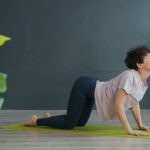What if you could transform your body, reduce back pain, and improve your balance with just one simple exercise that takes only 5 minutes a day? For people over 50, the humble plank might be the smartest workout you’re not doing yet.
After age 50, your body doesn’t need harder workouts—it needs smarter ones. The plank has quietly become a powerhouse for people over 50 who want to reduce back pain, tighten the midsection, improve posture, and boost balance, all without breaking a sweat.
Many doctors and physical therapists now recommend planks over traditional sit-ups and crunches, especially for those with more life experience.
5 Powerful Benefits of Daily Planking After 50
1. Stronger Core Protection Against Hernias
After 50, your core becomes much more than a vanity muscle—it’s your body’s natural armor. Weak core muscles can lead to hernias, especially among men over 50 and women post-menopause.
Unlike crunches that target surface-level abs, planks engage the deep stabilizing muscles—the transverse abdominis and internal obliques. These muscles act like a natural belt around your waist, holding everything in place.
When they get stronger, you’re not just preventing hernias; you’re building better posture, reducing pressure on your lower back, and even improving digestion by supporting the intestines properly.
2. Say Goodbye to Nagging Back Pain
Over 80% of adults over 50 report regular back pain, often due to muscle weakness and imbalance. When done correctly, planks activate not just your abs but your erector spinae—the long muscles running up and down your spine.
These muscles act like guide wires, helping to stabilize and support your back through everyday movements. Even better, planking builds this strength without compression.
Unlike sit-ups or squats that can load the spine, a properly aligned plank trains your back in a neutral, safe position. Most people start feeling real relief within the first 7 to 10 days of consistent practice.
3. Better Posture, Bigger Confidence
As we age, posture tends to collapse from hours of sitting, muscle imbalances, and gravity. The result? We look older and experience tight shoulders, neck pain, reduced lung capacity, and even digestive issues.
The plank activates and strengthens postural muscles simultaneously. When you hold a plank correctly, your body learns what aligned really feels like: head in line with the spine, shoulder blades pulled slightly back, and hips neutral.
This training translates into how you carry yourself daily—you look more energetic and people perceive you as more confident and capable.
4. Boost Metabolism and Burn Belly Fat
After 50, losing fat—especially around the belly—feels like a losing battle. Your metabolism naturally slows with age, muscle mass decreases, and hormones shift. But the plank creates a metabolic ripple effect through what’s called the afterburn effect or EPOC.
As a compound isometric exercise, planks activate multiple large muscle groups at once—core, shoulders, glutes, and even legs. This full-body engagement means your body continues to burn calories even after the exercise ends.
Strengthening your core muscles with planks also improves insulin sensitivity, meaning your body is better at processing sugars and less likely to store visceral fat around your midsection.
5. Improve Balance and Prevent Falls
According to the CDC, one out of every four Americans over 65 falls each year. These falls often lead to broken hips, hospital stays, or loss of independence.
Falls don’t happen because of age—they happen because of muscle loss, poor coordination, and weak stabilizer muscles.
When you hold a proper plank, your body activates not just the large visible muscles but also the tiny behind-the-scenes stabilizers around your hips, ankles, spine, and shoulders.
These are the muscles that catch you when you trip, help you balance stepping off a curb, or steady you when reaching for something high.
Planks train your brain and body to work in sync, building the kind of balance that keeps you moving with confidence.
How to Plank for 5 Minutes a Day Safely
You don’t need to hold a 5-minute plank all at once. Break it into five one-minute sets, resting 30 to 60 seconds between each. Focus on form over time:
- Keep your body in a straight line
- Shoulders over elbows
- Core tight
- Breathe slowly and steadily
Beginners can start with three sets of 30 seconds and build up gradually. You can also modify by planking on your knees or leaning against a countertop—these variations still provide excellent benefits. Remember, consistency beats intensity. A few focused minutes a day adds up fast.
Who Should Avoid Planks and Safety Tips
While planks are generally safe, they’re not for everyone. Consult your doctor first if you have:
- Uncontrolled high blood pressure
- Recent back or shoulder injuries
- Wrist pain
- Abdominal hernias
Poor form can lead to strain on the lower back or shoulders, so don’t sacrifice technique just to hit the clock.
If you ever feel dizzy, numb, or sharp pain, stop immediately. A smart workout is a safe workout—modify when needed and always listen to your body.
The Takeaway: 5 Minutes, A Lifetime of Strength
At this stage of life, you don’t need to run marathons or chase six-pack abs. What you do need is strength where it matters most: your core, your spine, your balance, and your confidence. That’s exactly what 5 minutes of plank a day delivers.
This one simple move helps prevent back pain, supports your posture, keeps your organs where they belong, improves your metabolism, and helps protect you from falls.
The beauty is in the simplicity: no equipment, no gym, just you, your body, and a few quiet minutes of commitment.
Imagine 3 months from now: you get up from a chair more easily, your back doesn’t ache after gardening, your clothes fit better, and you walk just a little taller.
That’s the power of a quiet, consistent practice. You don’t need to be perfect; you just need to show up, and your body will do the rest.








